When it comes to carpet racing, I’m late to the game. Specifically, carpet off-road. That’s a bit of an oxymoron, isn’t it? “Carpet off-road.” Now, I’ve raced 1/10 buggies in the past – I had a Losi 22 when they first came out, which, I quickly sold to my buddy Chris so that I could get an Associated B4. Later on, I converted to that car to mid-motor with the X-Factory kit. Those days were really fun, I think it was years 2010-2013? Something like that. Les, Chris, and I would pile into Les’s shitty Saturn Ion and we’d go to West Coast RC, OCRC or Airland – all indoor wet clay tracks. Good times. Eventually, I started to focus more on Nitro and didn’t keep up with electric offroad racing.
In 2017 (?) a new hobby shop opened up in the desert called Rise Up HobbyTown and they built a track in the warehouse behind the store. Around this time, indoor carpet tracks with modular jumps were popping up all over. At the time, these tracks were a bit divisive in the community because they were thought of as “not real offroad” and while I hadn’t driven an off-road car on this type of surface, I saw the appeal for multiple reasons: 1) A facility can easily host on and off-road racing. 2) The “offroad” cars stay very clean. 3) They don’t require a mini tractor (or the labor of a dozen men) to complete track layout changes.

So I go check out Rise Up, the facility and the track looked great! They went with CRC black carpet which was the latest and greatest for this type of racing. I got to try out a couple of people’s cars, one being an Associated B5 and the other was a Losi 4wd, both set up for carpet with proper tires, etc. I did not like it at all. The cars seemed extremely twitchy and very sensitive to how “straight” you landed jumps, this was really annoying because coming from 1/8 off-road, I’m used to scrubbing jumps when needed and landing at an angle, pointed toward the next corner. The whole driving experience wasn’t fun for me and I never went back.
Fast forward to a few months ago. Chris brought over his new two-wheel buggy so that I could solder up the electronics. I haven’t seen a 2wd buggy up close since the B4 era so I was very impressed with how far they have come in terms of design and quality. He originally got the car to race at a carpet track near where he lives in the bay area but plans changed when this pandemic started and he chose to come back to the desert to keep a low-profile. It ended up working out well since we have Rise Up here with their carpet off-road track.

A week or so later I went out to the track to watch Chris run his new car. This was the first club race after the first wave of lockdowns in California. The vibe was awesome! The turnout of racers was great and you could tell that everyone was really happy to be there. Also, for me, it was cool to see a bunch of the old characters I used to see at the outdoor tracks back in the day, and also my old pal Les was there.
So anyway, I’m watching the racing and I liked what I saw. The cars seemed to handle well and the racers were getting away with some aggressive driving styles that I didn’t know were possible on carpet. Les ended up not feeling well and didn’t want to run his main, so, he offered to let me drive. I figured what the heck, I’d been at the track for hours and was really itchin’ to drive. I started 7th or 8th in the b main and finished 3rd, just shy of the transfer to the main event. I was totally hooked. Les’s car was actually really fun to drive and I felt like I could drive the car how I wanted and it didn’t do anything weird like surprise traction-rolls etc.

Les has a TLR car that is a combination of parts from the Elite dirt car and the carpet car. I noticed in warm-up that the steering was very responsive near center and a slight under-steer at full-lock. I went -20% steering exponential and this helped as there wasn’t time to adapt to the car.
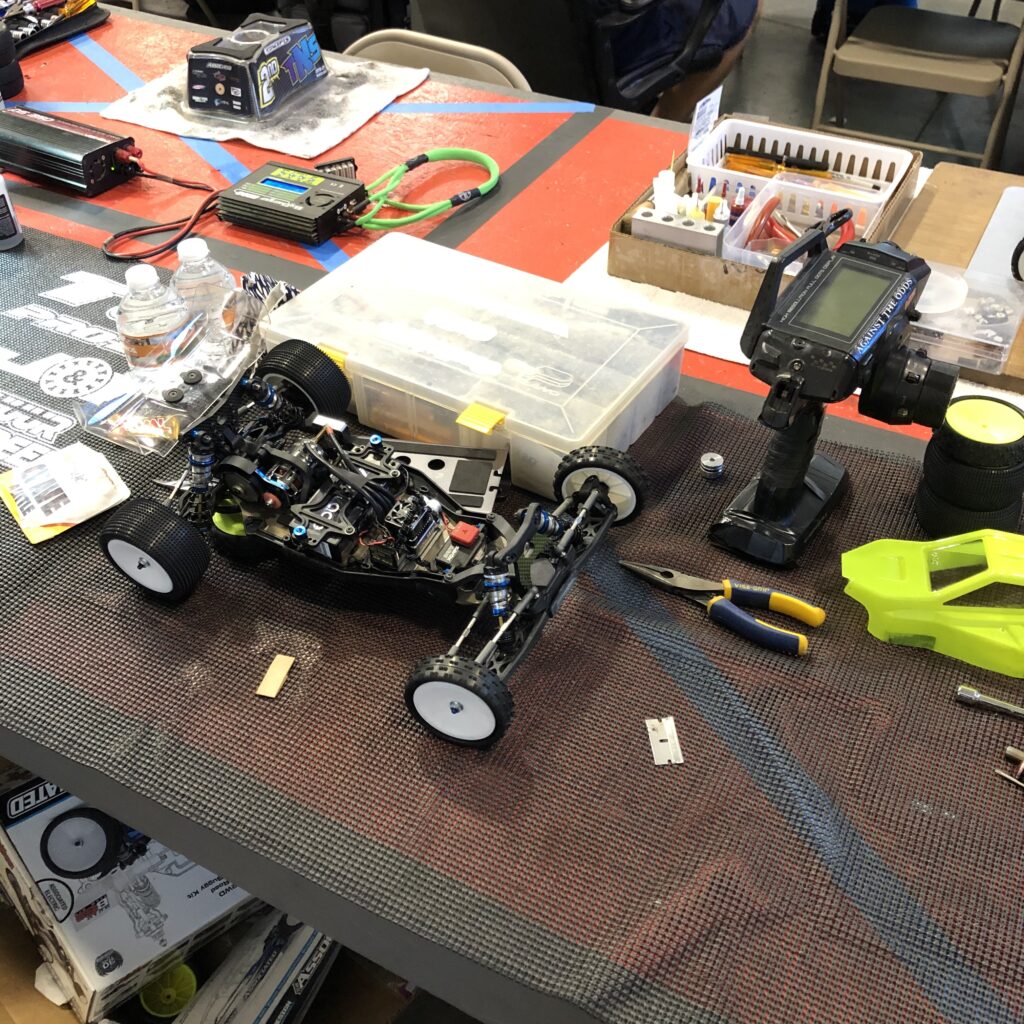
Don’t let Chris’s pit area fool you, his car and driving are on point.
Later on, I watched Chris’s race and his car looked dialed. I think he finished 2nd or 3rd. Afterward, I drove his buggy in practice and I was really impressed. He has the Associated car built to the kit setup and it was great. The initial steering response was softer compared to the TLR and it had more steering at full lock. So in that way, the car felt neutral: turn the wheel a bit and the car steers a little, turn more – steers more. Also, Chris’s car seemed a bit more stable when landing jumps. There was one jump, sort of a step-on step-off type, that really exposed any weakness in a car’s ability to land jumps and there I was more confident with Chris’s buggy.
As soon as I returned the transmitter to Chris I went into the hobby shop to buy a car. They had a TLR 22 5.0 AC (that’s a lot of letters and numbers) and they also had an Associated B6.2. I choose the B6.2 for a couple of reasons: 1) The fit and finish of the AE car is superb, the same could be said about the TLR but beyond that, I prefer the aesthetics of the AE. 2) The kit setup was good out of the box. I felt like I had no comments on the feel of the car and just wanted to run more laps. 3) I didn’t really like the idea of buying two kits to make one. In the case of Les’s car, he took all of the aluminum hop-ups included in the elite kit and installed them on the carpet car. The result is a very really nice looking build with all of the black anodized parts but I wasn’t interested in spending that much.

When I got home, I immediately got to work on the assembly. Well, first I grabbed a beer then dumped all the parts out.
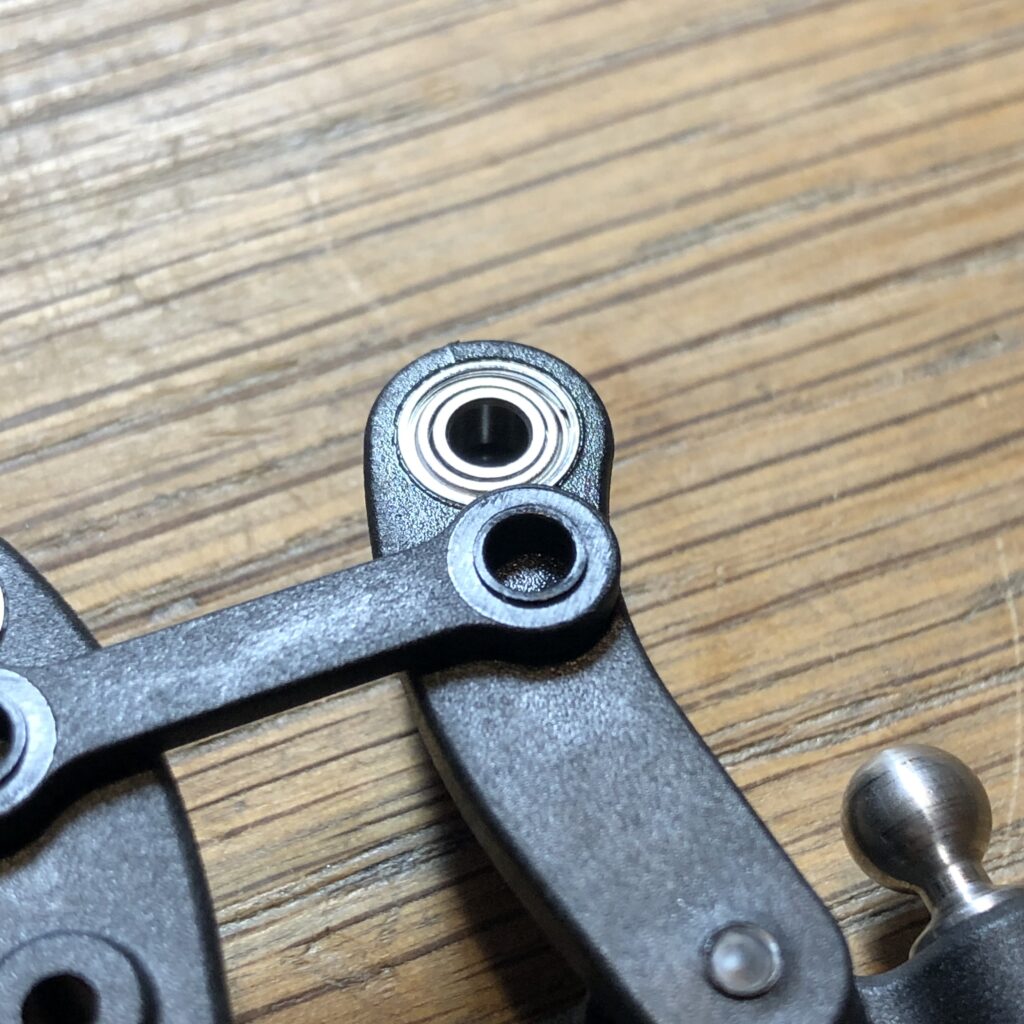
The first thing I noticed was the quality of the molded parts and I started to think about how much these cars have improved in recent years. For example, that little raised lip on the brace so that it only contacts the inner race of the bearings. With these sorts of details, parts can fit together tightly with little slop and still move freely.



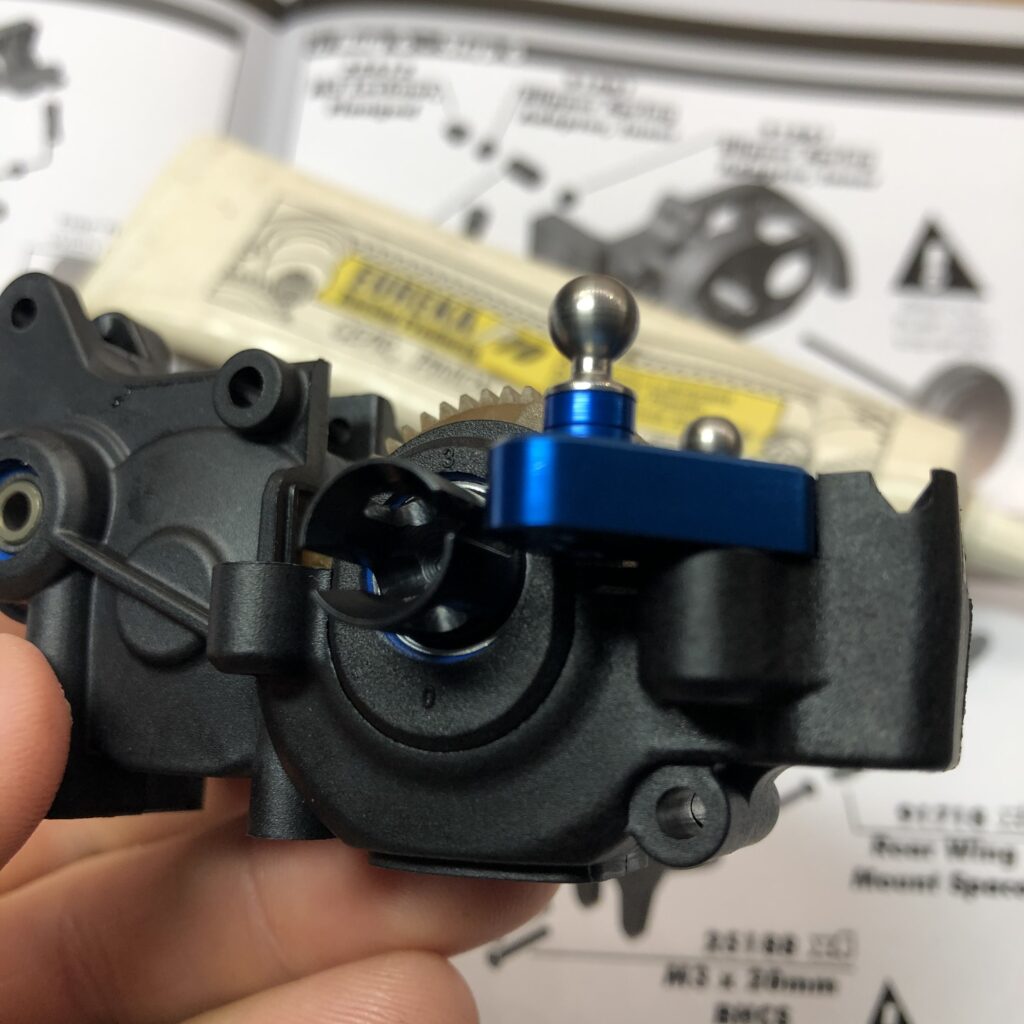
These are some of the molded parts that fit together with other molded or machined parts. Again, the fit and finish is really impressive. The inserts in the hubs have that perfect press-in fit and I like the little tabs they included to find its orientation. The transmission case is a new “quick access” style that is made up of three pieces and also has inserts to adjust the diff height. All of these parts fit together perfectly and the transmission spun free from the start.
Side note: I really like molded parts. Looking back that is one of my favorite things about the B4 and other cars from that era. Almost all of the parts were molded plastic. I just really like that aesthetic as opposed to all of the parts being machined aluminum or carbon. That stuff has it’s place but just doesn’t have the same feel as a molded part with all of its complex geometries.

I built my car box stock except I did included these servo mounting screws from 1up racing. They have that little shoulder under the screw head that keys into the mounting tab on the servo. I feel like this a must on this type of racing where precision is critical and these prevent the servo from shifting around on the mounts but I’m not sure if I would recommend these with a plastic case servo. Speaking of servos, I choose this one from Protek because it was low profile, aluminum case, and available from my LHS. For the price I was a bit let down by the quality – from the start, there has been clicking noises coming from the gears and I have to adjust sub-trim every couple of runs.

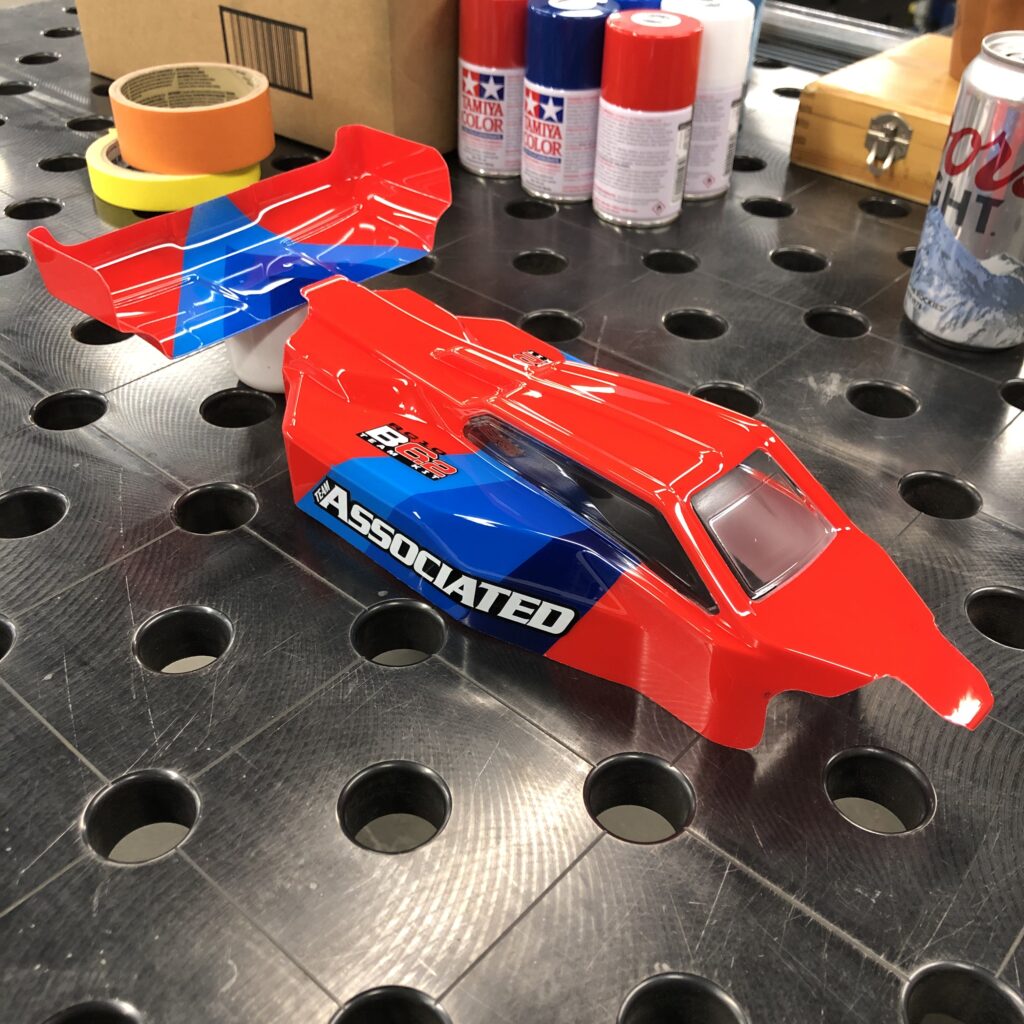
Painting… I’m starting to enjoy the process. I’ve been on this paint scheme since about 2014. I was originally inspired by the BMW race cars like this one and little by little I’ve been adding more red. Also, you can clearly see that I’m not into clear wings.

Almost done. I choose a SchuurSpeed 17.5 motor, Protek 4900 mAh battery and a friend of mine Steve lent me a new Hobbywing ESC. This worked out great for me as at the time all of the esc’s were on back-order due to the pandemic. Eventually, I would like to switch to the stock spec version as this one it just overkill.
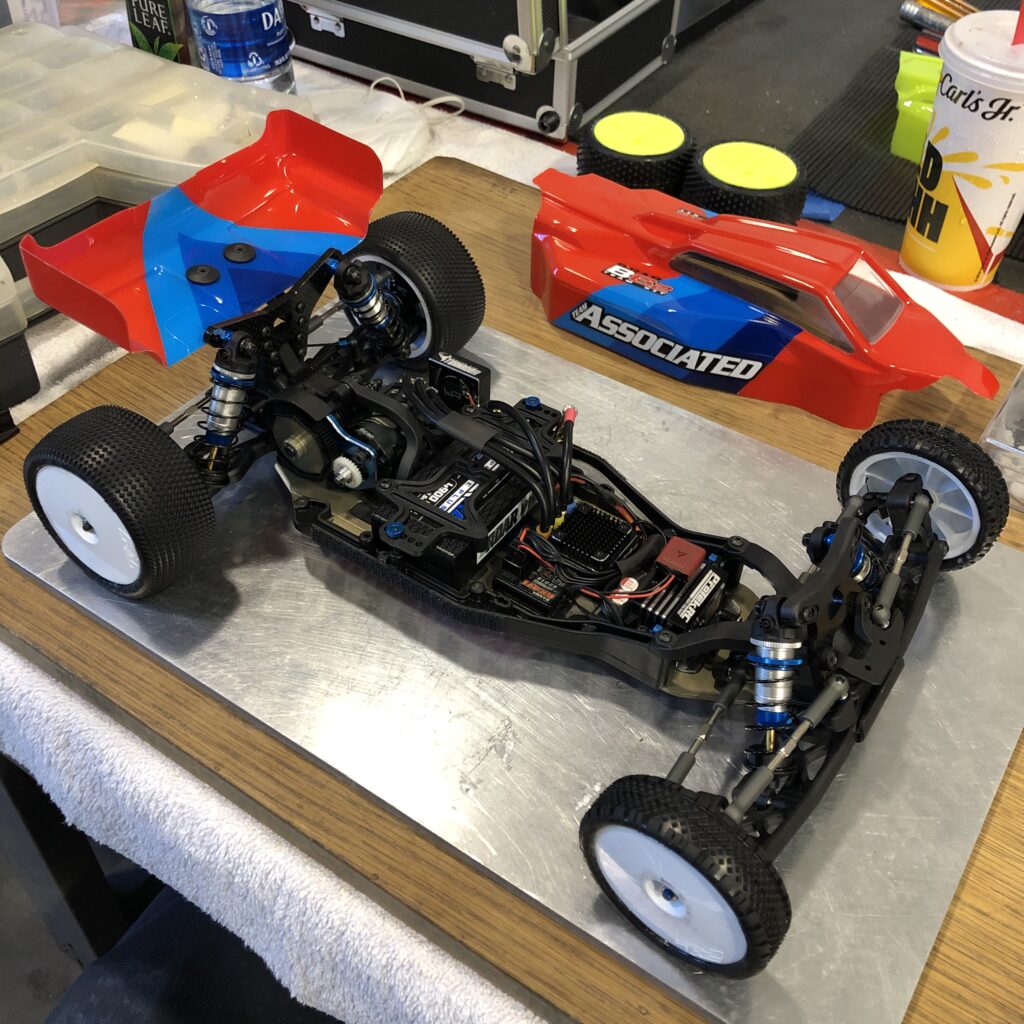
Finally, complete! I took my car for Wednesday night club racing. I got there just in time to get my battery charged and on the track for q1. I was really happy with my car straight out of the box. Fortunately, my gearing and motor timing were pretty good as my car was fast on the straight and the motor temps were warm but not too hot.

Chris ended up breaking his car in the warm-up of Q1 and I couldn’t help but laugh at him a bit. You can see he is also amused.

Then, I go do that same thing except worse – I choose to do it in the warm-up of the b-main. I had the feeling that it was some sort of karma for laughing at my friend earlier. It seemed to me that the cars are “engineered to fail” in this way where the ball cup pops off, then the arm breaks, and then if the crash is bad enough the shock cap breaks. This way only the lesser expensive plastics break and the metal parts don’t bend.
Again, Les offered me his car for the main, so I quickly swapped in my battery. It was fun and I had some close battles for position but missed the transfer spot to the A. There are some really fast local drivers which is good to see.
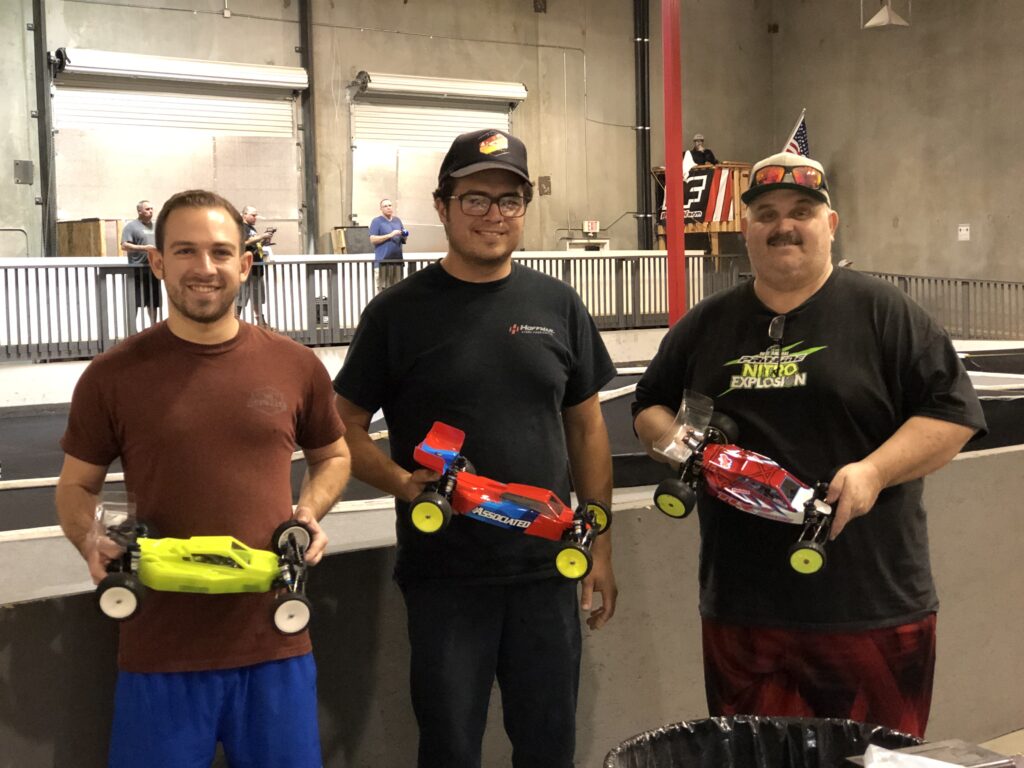
Chris on the left, myself center and Les on the right.
All in all, I’ve found carpet racing to be very enjoyable. I feel like the cars, tires, and setups have progressed so much in recent years. Before, when I tried it, I was driving basically a dirt car with a very low ride height and astroturf tires. Now, the cars are purpose-built for carpet with proper suspension geometry and weight distribution. Also, the tires are made specifically for carpet instead of a more general carpet/astroturf application. All of this results in a driving experience that is very enjoyable and the attitude of the car on the track seems more natural (especially for someone coming for loose dirt off-road.) I’m still amazed by the capabilities of these cars. Their corner speeds are almost as good as a 1/12 pan car (not really) and they can hit jumps and whoops – Unreal!!
Besides all of that, carpet racing is awesome for its own reasons:
1) Consistent track conditions – When I return to the track, within one or two laps I feel comfortable with my car and driving. I never got up to speed this quick in loose dirt as I always had to sort of calibrate for the current grip levels. Also, this makes it really easy to practice as at anytime the track is very similar to what it will be on race-day.
2) The traction is high and the “groove” is the full width of the lane – I feel like this makes it easier in the sense that a new racer can build a car box stock and go racing and not have to worry about the setup. Also, it is easier to recover from mistakes because you never get really loose.
3) It’s clean – I blow off my car with a powered duster and it’s ready for the next race. Parts and bearings don’t get bound up like they do in loose dirt and in general, there is far less prep-time in this type of racing which makes it easy to do on a weekly basis.
So for me, carpet racing has been working out great. It’s easy to do, not terribly expensive, and the racing has been very competitive. Learning what setup changes do in high-bite has been fun and I have a lot of ideas on how to improve the speed of my car. Anyway, If you made it all the way to here, thanks for reading, support your local tracks, cheers!
